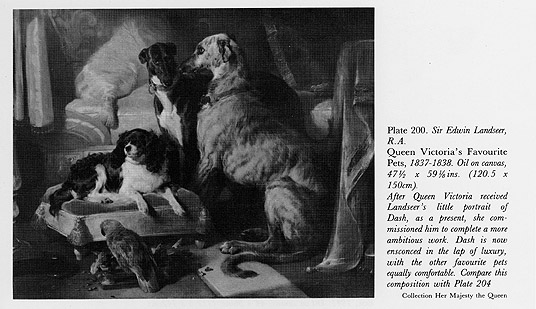
QUEEN VICTORIA AND SIR EDWIN LANDSEER
from Dog Painting, 1840-1940, A Social History of the Dog in Art
by William Secord
|
Queen Victoria came to the throne in 1837 at the young age of eighteen, herself
almost a child, and ill-prepared at such an age to rule the vast empire then
under British rule. William IV's reign had been short lived (1830-1837) and
Victoria, born in 1819, had been the only child of William's brother Edward.
Victoria's father, The Duke of Kent, and the 4th son of George III, had not
married until the age of fifty, when on May 29, 1818 he married the dowager
Princess of Leiningen, now part of Germany. The couple soon gave birth to little
Victoria on May 24, 1819, and while some in the Royal family had reason to doubt
that she would ever come to the throne, from the very beginning her father the
Duke of Kent had no doubt. She was virtually brought up by her governess, the
beloved Baroness Lehzen, and her childhood was ordered and disciplined in a
manner befitting a future queen. |
| First | Previous | Next | Last |
Home | About
the WS Gallery | Current
Exhibition | New
Additions | Search Our Inventory
| Commissioning Paintings | 19th
& 20th Century Oils | Contemporary
Artists | Works
on Paper & Collectibles | Books
| Christine Merrill
| Guest book | Email
Us
All images, designs and information on this site
are fully copyrighted © 1999
and may not be reproduced of used in any form or any manner, or displayed in
any way
on any website without the express written consent of The William Secord Gallery,
Inc.
William Secord Gallery, Inc.
29 West 15th Street 4th floor
New York, NY 10011
Between Fifth and Six Avenues
www.dogpainting.com
wsecord@dogpainting.com
Tel. 212-249-0075
212-249-0896
By appointment
